Lean Body Mass Program
Spartanmedicalassociates.com Weight loss medication treatment available separately
- We cannot burn fat in the presence of insulin!
- High insulin levels cause weight gain and obesity!
- What and when we eat is the key to lowering insulin levels!
- This works as a stand alone regimen but combining this plan with optimized hormones will yield superior results!
Weight gain and obesity are associated with a significant increase in chronic, life threatening diseases including diabetes mellitus, hypertension, high cholesterol, heart disease, stroke, sleep apnea, cancer and death. Weight loss is one of the most important interventions one can make to improve longevity, life span and health span.
Obesity in the United States has reached a crisis level over the past 30 years due to our Western diet with a marked increase in processed carbohydrates and refined sugars. The nutrition industry has massively profited at the expense of American’s health and taxpayer dollars spent on treating preventable diseases. The American Diabetic Association and American Heart Association have contributed to this problem with their dietary recommendations which minimized fat and calories rather than reduce processed carbohydrates and refined sugar.
Processed carbohydrates and refined sugars cause marked spikes in insulin levels. The presence of insulin persistent over time is the main driver of fat being deposited in fat cells. When we eat a diet high in carbohydrates and sugar, these foods cause a spike in glucose which causes the pancreas to release insulin. Insulin causes glucose to be stored in the liver as glycogen. Once the liver is full, insulin causes excess glucose to be converted in the liver to fatty acids (Lipogenesis). Then insulin drives these fatty acids into cells causing fat gain eventually leading to obesity. Given enough time of high carbohydrate/sugar and a frequent feeding diet we develop obesity, insulin resistance and type 2 diabetes.

Low carbohydrate and low refined sugar nutrition plans have been found to markedly improve lean body mass, reduce the incidence of obesity associated disease and even cure type 2 diabetes. Additionally periods of fasting and time restricted feeding mimic the nutritional pattern of our paleo ancestors which allows our body to purge itself of excess glucose and fat because insulin levels are low. We cannot burn fat in the presence of insulin!
Poor sleep can also contribute by elevating cortisol levels which causes elevation of glucose levels causing insulin secretion which drives fat deposition. Exercise depletes the glucose reservoirs in our muscles allowing further space to store excess glucose rather than in the fat cells.
Our Lean Body Mass Program combines 4 principles.
- Low carbohydrate/sugar diet that lowers your insulin levels
- Ketogenic foods that maximize fat burning
- Time restricted feeding on a daily basis
- Intermittent fasting
How Do We Burn Calories?
The majority of our calories are expended on our Basal Metabolic Rate (BMR) which is the energy it takes to run our bodies systems and maintain homeostasis each day. Digestion and daily activity utilize the second most calories and exercise makes up the rest of our caloric expenditures.
- Basal metabolic rate – women 1500 cal, men 1650 cal.
- Digestion – 400-600
- Daily activity – 500 – 700
- Exercise – 200 – 500
You can see by these numbers that exercise has only a modest impact on the balance of “calories in” versus “calories out”. We can make a MUCH greater impact on caloric balance by changing our nutrition. Here is a link to a podcast with Dr. Jason Fung author of The Obesity Code discussing the metabolic processes that cause obesity and how to combat this.

Time-restricted eating
Fed vs. fasted
Your body is designed to smoothly transition between two different and opposing states: ‘Fed’, and ‘Fasted’. In the fed state, insulin is elevated, and this signals your body to store excess calories in your fat cells. In the presence of insulin, the burning of fat is halted, while the body burns glucose (from your last meal) instead.
In the fasted state, insulin is low (while glucagon and growth hormone, opposing hormones to insulin, are elevated). The body starts mobilizing stored body fat from your fat cells and burning this fat for energy (instead of glucose).
The practical importance of all this? You can only burn stored body fat while in the fasted state, and you can only store more body fat while in the fed state.

Humans have the ability to become ‘fatadapted’ and improve their ability to fuel themselves with stored body fat instead of glucose. However, this takes time and practice, and your body has to do a number of things to slowly up-regulate (or increase) your fat-burning pathways.
This includes improving insulin sensitivity to lower insulin and promote fat mobilization into free fatty acids from adipocytes (fat cells) as well as upregulating the fat-burning pathways at the cellular level (in the mitochondria). There are several ways to improve ‘fat adaptation’ or the ability to successfully burn stored body fat for energy, and these include the following:
- Low carbohydrate diets. Eating a Low Carb Healthy Fat (LCHF) diet improves the body’s ability to utilize fat for energy rather than glucose, as there is more fat and less glucose available at all times, even in the fed state.
- Exercise. High-intensity exercise depletes glucose and glycogen rapidly, forcing the body to switch over and utilize more fat for fuel. Exercise also improves insulin sensitivity.
- Caloric restriction. Eating fewer calories also equals less glucose available for fuel, so the body is more frequently forced to rely on stored body fat for fuel. You will always naturally eat the lowest calories when you are maximizing nutrient density by eating whole, natural, unprocessed, real foods found in nature (avoid processed foods completely).
- Intermittent fasting, and spending more time in the fasted state, which gives the body more ‘practice’ at burning fat.
Metabolic Exercise
The purpose of this is to highlight INTERMITTENT FASTING as a strategy for exercising and strengthening the body’s ability to exist in the fasted state, burning fat instead of continually burning sugar (glucose) from the fed state.
Just like anything else, this ability can be strengthened over time with practice. But this ability also atrophies or shrinks over time with lack of use, just like your muscles atrophy when you break your arm and have to wear a cast for weeks. Spending time in the fasted state is actually a form of exercise—a METABOLIC WORKOUT.
In fact, there are a lot of parallels between exercise and fasting. Exercise does all of the following great things:
- Decreases blood glucose.
- Decreases insulin level.
- Increases insulin sensitivity.
- Increases lipolysis and free fatty acid mobilization.
- Increases cellular fat oxidation.
- Increases glucagon (the opposite of insulin).
- Increases growth hormone (the opposite of insulin).
BUT did you know you can also accomplish all of the above by doing ABSOLUTELY NOTHING? The secret is *FASTING*.
Extending the amount of time that you spend during your day in the FASTED state (as opposed to the FED state) accomplishes all of these, very similar to exercise. Extending your time in the fasted state is actually a form of metabolic ‘exercise’, in which you train your body to rapidly and efficiently mobilize free fatty acids from your adipose stores (fat tissue), something you absolutely can get better and better at with the metabolic ‘practice’ of fasting.
Just as overweight and out of shape people struggle to jog or lift weights or participate in other forms of physical exercise, they are also generally out of practice when it comes to rapidly and efficiently mobilizing and burning stored free fatty acids for fuel. Intermittent fasting and spending more of your day in the ‘fasted’ state (and less time in the ‘fed’ state) is a great form of metabolic ‘exercise’ which has many health benefits, including fat loss!

Less feeding, more fasting
One of the best ways to achieve effortless and long-lasting fat loss? Train yourself to eat two meals a day (and eliminate snacking). The easiest and best way to accomplish this? Leverage your natural overnight fast by skipping breakfast (drinking coffee makes this easier and more enjoyable, plus coffee has numerous health benefits).
No breakfast, lighter lunch, and larger dinner also maximizes the body’s natural shifts between sympathetic (“fight or flight”) and parasympathetic (“rest and digest”) nervous system tone, with higher alertness and activation from sympathetic tone during the day while under-eating, and higher parasympathetic resting tone in the evening during the fed state.
Typically, the fed state starts when you begin eating and for the next three to five hours your body digests and absorbs the food you just ate. Insulin rises significantly, completely shutting off fat-burning and also triggering excess calories to be stored as fat.
After the first few hours mentioned above, your body goes into what is known as the post–absorptive state, during which the components of the last meal are still in the circulation. The post–absorptive state lasts until 8 to 12 hours after your last meal, which is when you enter the fasted state. It typically takes 12 hours after your last meal to fully enter the fasted state.
When you’re in the fasted state your body can burn fat that has been inaccessible during the fed state. Because we don’t enter the fasted state until 12 hours after our last meal, it’s rare that our bodies are in this fat burning state. This is one of the reasons why many people who start intermittent fasting will lose fat without changing what they eat, how much they eat, or how often they exercise. Fasting puts your body in a fat burning state that you rarely get to enter during a normal eating schedule.

Avoid Carbohydrates
Eating carbohydrates, especially refined carbohydrates with no fiber, overdrives the ‘fed’ state, as carbohydrates raise both glucose and insulin higher than other macronutrients (fat, on the other hand, raises glucose and insulin the very least).
In general, when you eat a meal, your body spends a few hours processing that food and burning what it can from what you just consumed. Because it has all of this readily available, easy to burn energy in its blood stream (thanks to the food you ate), your body will choose to use that as energy rather than the fat you have stored.
This is ESPECIALLY true if you just consumed carbohydrates, because these are rapidly converted to glucose and your body prefers to burn sugar as energy before any other source (high glucose is toxic and your body burns extra glucose preferentially to get rid of it, much in the same way that the body burns alcohol consumed for energy prior to other energy calories–alcohol therefore also sabotages fat loss).

Exercise helps
Exercise helps greatly with fat adaptation. Your glycogen (the storage form of glucose in your muscles and liver that your body can burn as fuel when necessary) is depleted during sleep and fasting, and will be depleted even further during training, which can further increase insulin sensitivity.
This means that a meal immediately following your workout will be stored most efficiently: mostly as glycogen for muscle stores, burned as energy immediately to help with the recovery process, with minimal amounts stored as fat. Compare this to a regular day (no intermittent fasting).
With insulin sensitivity at normal levels, the carbs and foods consumed will see full glycogen stores, enough glucose in the blood stream, and thus be more likely to get stored as fat.

Fasting Myths
Myth #1 –
“Breakfast is the most important meal of the day!”
We have all been told to eat breakfast. Unfortunately this is terrible advice. When you first wake up in the morning, your insulin level is quite low and most people are just starting to enter the fasted state, 12 hours after eating the last meal of the previous day. The worst thing you could do is to eat food, spiking insulin and glucose and immediately shutting off fat-burning. A much better choice would be to push the first meal of your day out at least a few hours, during which you can fully enter the fasted state and burn stored body fat.
The VERY WORST would be to eat a high carbohydrate breakfast, spiking insulin and glucose as high as possible; in addition to shutting off fat-burning for likely 12 hours, this will drive as many calories as possible into fat stores as well as providing further reinforcement of the burning of glucose rather than fat.
Also, high spikes of insulin and glucose always lead to large drops in glucose a few hours later, which triggers HUNGER (if you want to have hypoglycemia or low blood sugar and ravenous hunger, just eat a breakfast of pure carbohydrates and then wait 2-3 hours to see how you feel). Interestingly, many properly fat-adapted people aren’t very hungry in the morning and have no problem skipping breakfast.
This is appropriate, as throughout our evolution humans have always been hunter-gatherers and rather than eating a large breakfast first thing in the morning we would hunt and gather throughout the day, having a larger meal later in the day. We highly recommend mimicking this pattern by skipping breakfast and eating most of your calories later in the day (referred to as a ‘reverse taper’ of calories, with none in the morning and most in the evening).
Myth #2 – “Eat small frequent meals.”
There has been plenty of worthless advice here. We have been told to eat frequently to “keep your metabolism going” and “don’t let your body enter starvation mode”. This is all the exact opposite of the truth: in order to burn fat, you want to spend as much time in the fasted state as possible and get very very efficient at living on stored body fat rather than caloric intake from constantly eating.
Similarly, we have been told to eat protein frequently throughout the day in order to build muscle, and this is also not evidence-based. Yes, you do want to eat an adequate amount of protein to build muscle, but eating it once a day is plenty.

Myth #3 – “Fasting leads to burning muscle instead of fat.”
Many people are concerned that if they start fasting they will either stop making muscle or maybe even burn muscle. This is not true. If this were true, humans would not be here today. In fact, growth hormone is increased during fasted states (both during sleep and after a period of fasting). Growth hormone might as well be called “fasting hormone”, as it rises by as much as 2,000% after 24 hours of fasting.
Growth hormone is highly anabolic (builds muscle), and is used in combination with testosterone by bodybuilders who want to simultaneously build as much muscle and burn as much fat as possible. Growth hormone elevates in fasting to help preserve muscle in times of fasting, and this makes sense. In our hunter-gatherer ancestors, if fasting and going without food made you weaker and slower you would never catch or find any food and you would die and humans would become extinct.
In fact the opposite is true; while fasting, muscle is preserved or can even grow if you are doing resistance training (highly recommended). Also, people experience an increased level of focus and alertness during fasting thanks to the release of epinephrine and norepinephrine (earlier in our evolution this increased energy and alertness helped us catch prey when necessary).
Myth #4 – “Your metabolism slows down when you are fasting.”
This is completely false. A number of studies have proven that in fasting up to 72 hours, metabolism does not slow down at all and in fact might speed up slightly thanks to the release of catecholamines (epinephrine or adrenaline, norepinephrine, and dopamine) and activation of the sympathetic nervous system (sympathetic nervous system is often considered the “fight or flight” system, while the opposite is the parasympathetic nervous system or the “rest and digest” system).
It makes sense that this fight or flight sympathetic nervous system would be activated during the daytime, when hunter-gatherer humans are most active and in the fasted state (looking for food), followed by parasympathetic “rest and digest” mode in the evening after eating a large meal.
Myth #5 – “If I don’t eat I will get low blood sugar [hypoglycemia].”
Studies have shown that healthy persons who have no underlying medical conditions, who are not taking any diabetes medications, can fast for extremely long periods of time without suffering from any hypoglycemia. In fact, almost all sensations of hypoglycemia or low blood sugar (in non-diabetics) results from eating a very high glycemic index carbohydrate food a few hours prior (blood sugar spikes, then insulin spikes, then blood sugar drops rapidly).
However if you are a diabetic, especially if you are on any diabetes medications, you definitely need to check with your doctor before starting a fasting protocol. Some diabetes medications can lead to severe hypoglycemia when fasting (mostly insulin and sulfonylurea drugs like glipizide, glimepiride, and glyburide). [Be sure to check with your doctor prior to starting a fasting protocol if you have any medical problems, diabetes or otherwise.]
How to fast intermittently
There are a number of ways to actually perform intermittent fasting, but the easiest and most popular varieties involve taking advantage of your natural overnight fast by skipping breakfast and pushing the first meal of the day forward a number of hours. Once you have passed the 12 hour mark from dinner the night before, you are truly in a fasted state and you begin to rely on stored body fat for fuel.
The longer you stay in the fasted state, the more metabolic practice you will get at burning stored body fat and the deeper your fat adaptation will get. In fact, if you can maintain this intermittent fast for 20 to 24 hours you will achieve a very high rate of lipolysis (breakdown of stored body fat into free fatty acids, available for burning in the cells) and fat oxidation (burning of fat in the mitochondria).
When you first start out with intermittent fasting, you can have quite a bit of hunger and low energy and other symptoms. In this case we recommend starting out with “baby steps”, by just pushing breakfast out an hour or two at first, then slowly increasing the fasting interval. As time goes by and you become more “fat adapted”, it is easier and easier to fast. This is identical to exercise in those who are sedentary: it is painful and extremely difficult at first, and then once you are adapted it gets easy and even enjoyable.
LCHF diet for fat adaptation
It is much easier to fast if you are already on a LCHF (low carb healthy fat) diet, as these diets naturally lead to quite a bit of fat adaptation and are naturally lower in the secretion of insulin as well as the utilization of glucose as a fuel. In fact, we HIGHLY recommend the combination of a very low carb diet with intermittent fasting.
The closer you get to a ketogenic diet (extremely low in carbohydrates, moderate in protein, and high in fat) the easier it is to go for hours and hours without eating, thanks to the fat adaptation that these diets lead to.
For those who do incorporate carbohydrates in the diet, we would recommend that these mostly consist of FIBER, which is indigestible and does not contribute to the elevation of glucose and insulin. If you do decide to eat digestible carbohydrates, we would DEFINITELY NEVER eat these early in the day, as this will contribute hugely to fat storage and sabotage fat burning a lot, as well as setting you up for a blood sugar and hunger roller coaster for the rest of the day.
We would ONLY eat digestible (non-fiber) carbohydrates in the evening, and ideally only after either fasting for a long period (to deplete liver glycogen) or exercising with a high level of intensity to deplete muscle glycogen (eating digestible carbohydrates when your muscle and liver glycogen are already full is guaranteed to lead to fat storage and worsening insulin sensitivity, the exact opposite of what you are looking for).
Popular forms of intermittent fasting

There are several popular ways to accomplish intermittent fasting and we will discuss the three most popular varieties next. All of these involve lengthening the overnight fast by skipping breakfast and postponing the first meal of the day. All of these also involve eating no calories at the beginning of the day and the majority of your calories very late in the day, a concept called a caloric ‘reverse taper’.

Keep in mind that for the purpose of these discussions we will consider the baseline standard diet to involve 12 hours of fasting (overnight) plus 12 hours of an eating window during the day consisting of three meals, breakfast, lunch, and dinner. The sad reality however is that most people are actually eating first thing in the morning until late at night, with lots of snacking, so the eating window for the average American is probably even larger than 12 hours.
Leangains – also called 16:8
Leangains, as popularized by bodybuilder Martin Berkhan, is by far the most popular method of fasting intermittently. This form of fasting consists of skipping breakfast every morning and pushing the first meal of the day to lunch. Basically you skip breakfast and then eat a normal lunch and dinner in an eight hour window. The idea is to fast for 16 hours (overnight plus the first ~6 hours of your day), then eat all your calories in an 8 hour window.
For example, let’s say you get up at 6:00 a.m. You would skip breakfast and eat nothing for six hours, then lunch at noon and dinner at 8:00 p.m. Snacking inside your eating window is allowed (although we will say that generally speaking you want to try to consolidate calories into larger meals rather than snacking). This 16:8 split (16 hours fasting and 8 hours eating) is recommended every single day.

If you had one day off from this protocol and followed this the other six days of the week, that would amount to an additional 4 hours of fasting per day compared to the standard 12:12 split that we are assuming to be baseline (12 hours fasting and 12 hours eating). Four hours per day times six days per week equals about 24 hours of total additional fasting per week. [4 hours fasting per day times 6 days per week = 24 hours]
Warrior diet
The Warrior Diet, as popularized by Ori Hofmekler, consists of fasting during the majority of the day, then eating all of your calories in the evening. The goal is to skip breakfast and lunch, then eat a huge dinner in a four hour window at the end of the day. This is a 20:4 hour split (20 hours of fasting and then a 4 hour eating window at the end of the day).
This method of fasting does allow you to eat very large very satisfying meals at the end of the day, and might be perfect for someone who was going out to dinner to eat in a social setting, where a ton of calories and food might be involved.
Fasting this long during the day is more difficult but does lead to a deeper level of fat adaptation and low insulin (which helps improve insulin sensitivity). If one followed this protocol roughly every other day (let’s say three days a week), that would equate to eight hours of fasting compared to the 12:12 baseline standard diet, times three days per week would also equal about 24 hours of total additional fasting per week. [8 hours fasting per day times 3 days per week = 24 hours]
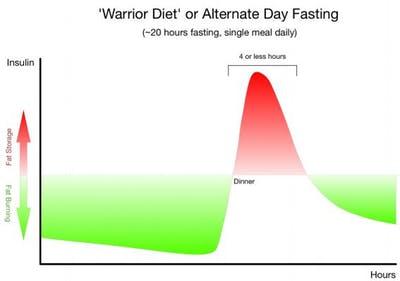
Eat stop eat
Eat stop eat, as popularized by bodybuilder Brad Pilon, involves fasting for an entire 24 hours, two days per week. Let’s say you eat your last meal of the day at 8:00 p.m. the day before. You fast overnight and then all the following day, skipping breakfast and lunch, and then pushing dinner out to 8:00 p.m. (for a full 24 hours with no calories).
This is quite difficult and is only recommended two days per week (nonconsecutive). While this is quite difficult, by the end of the 24 hours you do reach a very deep level of lipolysis and fat oxidation, with very low insulin levels, and this is quite desirable. Many people think that the following day they will binge on so much food that the benefits of the fasting on the previous day will be negated, but this is not true.
Studies have repeatedly shown that persons will overeat by hundreds of calories the next day, but still not come anywhere close to eating as much as they would have by eating normally both days (in other words, you are still left with a large net caloric deficit even after eating more food the day after your fast).
Each day that you fast in this fashion adds 12 hours of fasting compared to the standard 12:12 split we are calling baseline, and two days per week of this again equals about 24 hours of total additional fasting per week. [12 hours fasting per day times 2 days per week = 24 hours]
It’s all good
With all of these fasting methods, the goal is to skip breakfast, avoid snacking, and consolidate calories near the end of the day. All of these methods are quite effective, and you can in fact mix and match these as much as you would like. We would highly recommend keeping it flexible. Fast for as long as is convenient on any given day, and break your fast whenever you need to or want to. Anything beyond a 12 hour window is going to be at least somewhat beneficial towards anyone’s goals.
If you planned on fasting 16 hours but only make it 13, that’s ok and you are still much better off than if you had eaten all day long with early and late calories plus lots of snacking. We think a good goal would be 24 hours per week of additional fasting (additional to the standard 12:12 baseline). This could be 2 days of 24 hour fasting (Eat Stop Eat), 3 days of 8 hour fasting (Warrior Diet), or 6 days of 4 hour fasting (Leangains).
You could also mix and match as desired. Keep it flexible and go with whatever best suits your schedule and your lifestyle and your current level of fat adaptation.
Coffee = awesome
During the fasts feel free to drink ANY noncaloric beverage you want, including but not limited to: water, coffee (with or without noncaloric sweetener such as stevia), tea (hot or iced, sweetened with stevia if desired), diet soda with no calories, or any other beverage with no calories. However we would NOT recommend any calories AT ALL, as it takes frightfully few calories to spike insulin and sabotage your fast. Fat is the macronutrient that spikes insulin the very least, which is why so many people are using Bulletproof coffee or some other method of adding fat (butter, coconut oil, etc) to coffee in the morning.
However, we would NOT recommend this or any other source of calories while fasting, as this will be detrimental to what you are trying to accomplish with fasting. If you will absolutely die without at least a tiny splash of cream in your coffee well then do it, you will be better off with it than if this prohibition against cream in your coffee keeps you from trying to fast intermittently at all (95% fasting much better than 0% fasting)!
However we would try to keep the cream in your coffee to an absolute MINIMUM quantity, and you should also use this opportunity to learn to drink coffee black (this is something anyone can learn over time, believe it or not). We *HIGHLY* recommend the use of black coffee or tea in the morning to make your fast easier and more enjoyable. Both coffee and tea have numerous health benefits, and they both contain compounds that help with fat burning, energy, and alertness.
Enjoy your new found freedom from food
Once you are properly fat adapted, intermittent fasting is actually easy, fun, enjoyable, and liberating—while making you leaner and healthier in the process! Let’s say you are following the Leangains protocol. Breakfast every day during the work week is now JUST BLACK COFFEE, how easy is that? No more worrying about what you are going to grab for breakfast as you rush around in the morning and struggle to get to work on time.
This saves you a ton of time and work and effort and is literally a form of metabolic exercise in the meantime, improving your insulin sensitivity and strengthening your fat adaptation. This is a win in many ways. It also frees you to eat very large and satisfying meals in the evening, without feeling the deprivation of watching calories or restricting yourself.
And on days where you skip breakfast and lunch, you will be amazed at how much extra time you will have when you don’t have to worry about what to eat, where to get it, and when to find time to eat it. Your productivity will be higher as concentration and focus is higher in the fasted state (thanks to the sympathetic nervous system activation and catecholamines), and you will have more free time.

Visual Guide To Carbohydrates in Food
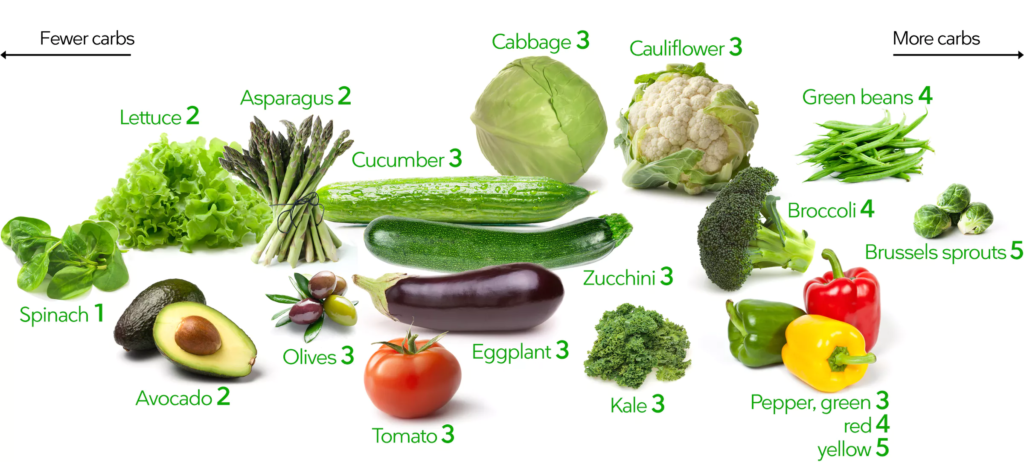

Note the difference between above-ground and below-ground vegetables. Vegetables with less than 5 percent carbs may be eaten relatively freely. If you’re on a not-too-strict low-carb diet (more than 20 grams per day), you can probably eat all you want of all these low-carb vegetables.
If you’re on a keto low-carb diet (below 20 grams a day), you may need to be a bit careful with some of the vegetables. You should probably be especially careful with bell peppers or tomatoes – these carbs quickly add up towards the 20 grams-a-day limit. Just one medium-sized bell pepper may contain 4-7 grams of digestible carbs.
Berries
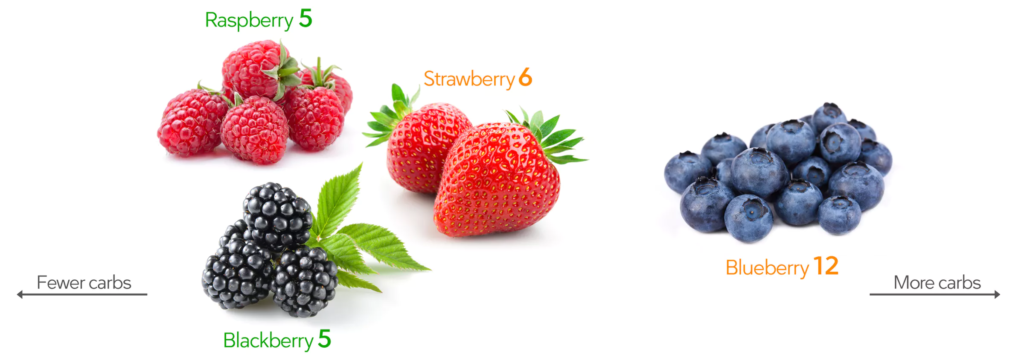
Fruits
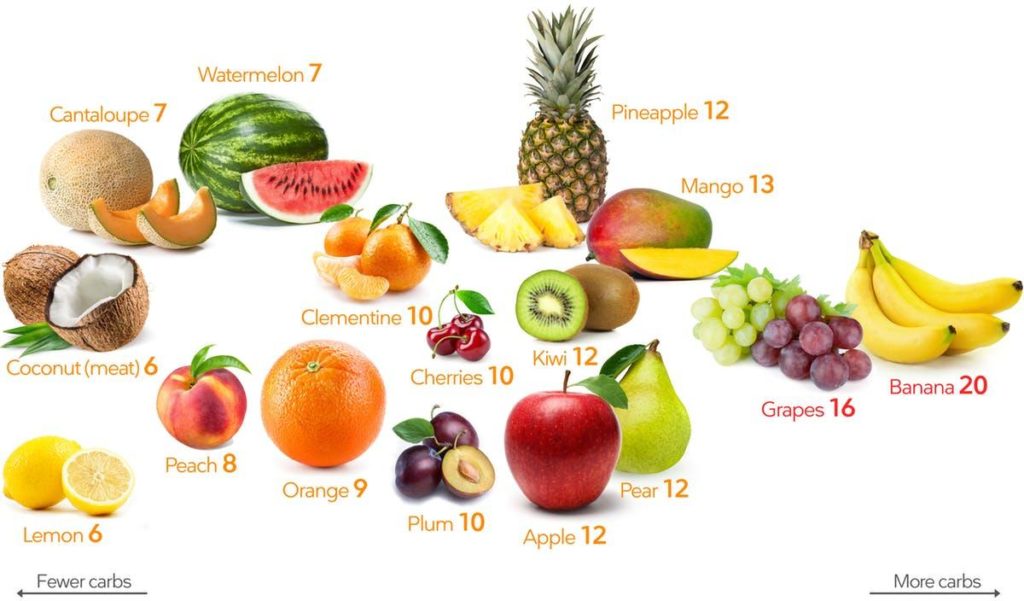
How much fruit can you have?
This means that on a keto low-carb diet (<20 grams per day) you’re probably better off having some berries instead. You don’t actually need to eat fruit. You can get any nutrient in fruit from vegetables – without all the sugar. Therefore, perhaps you want to try eating plenty of low-carb vegetables instead.
Even on a more moderate low-carb diet (20-50 grams per day) you’ll have to be careful with fruit – probably no more than about one a day.
On a liberal low-carb diet (50-100 grams per day) you may be able to squeeze in two or three fruits a day, if that is your biggest source of carbs.
As you see, grapes and bananas are the highest-carb fruits of them all.
Nuts
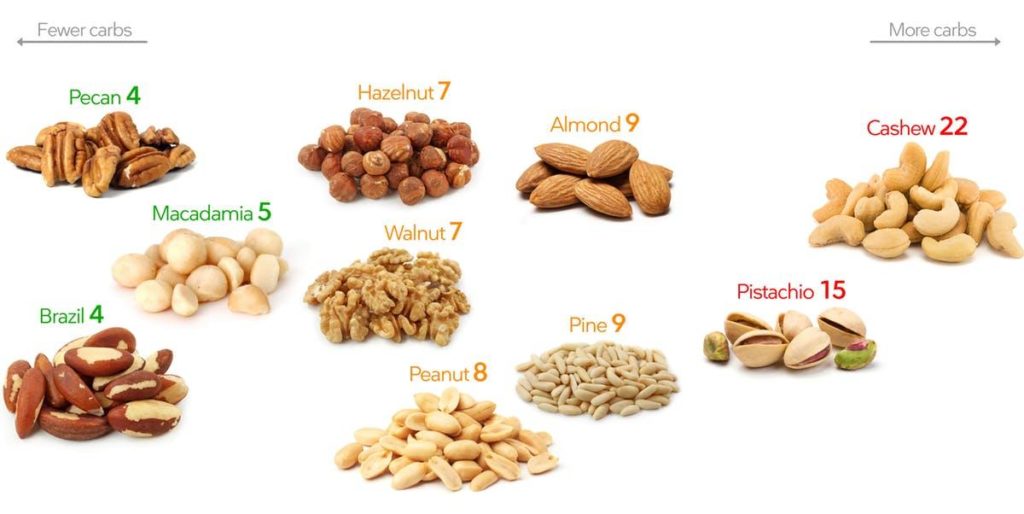
The numbers below the nuts are the percent of digestible carbohydrates, i.e net carbs. This means that a hundred grams of nuts (3½ ounces or about three handfuls) will contain this many net carbs.
No preparation needed
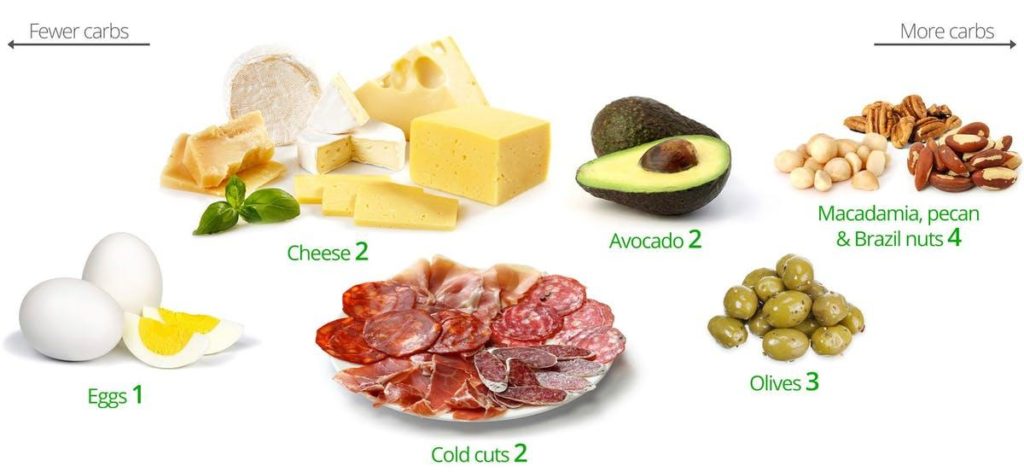
How many carbs in adult beverages?
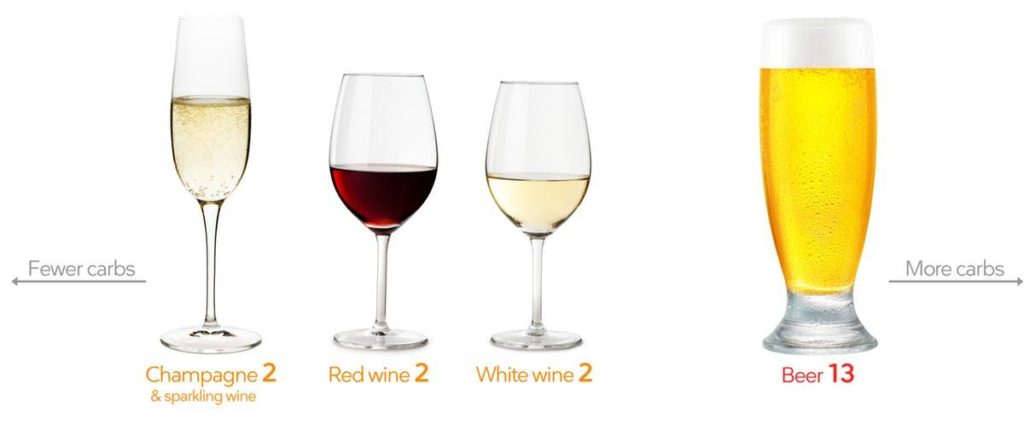
Beer: how many carbs?
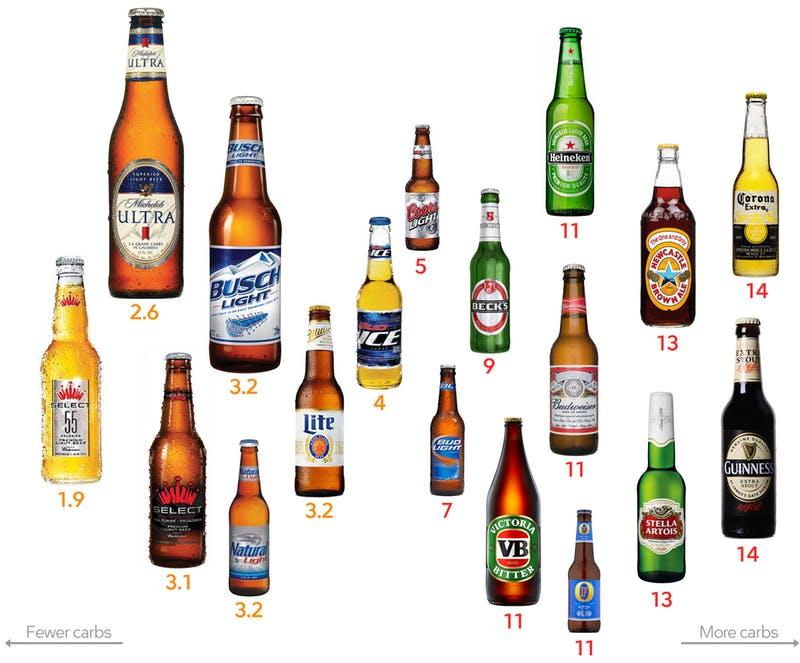
Spirits: how many carbs?
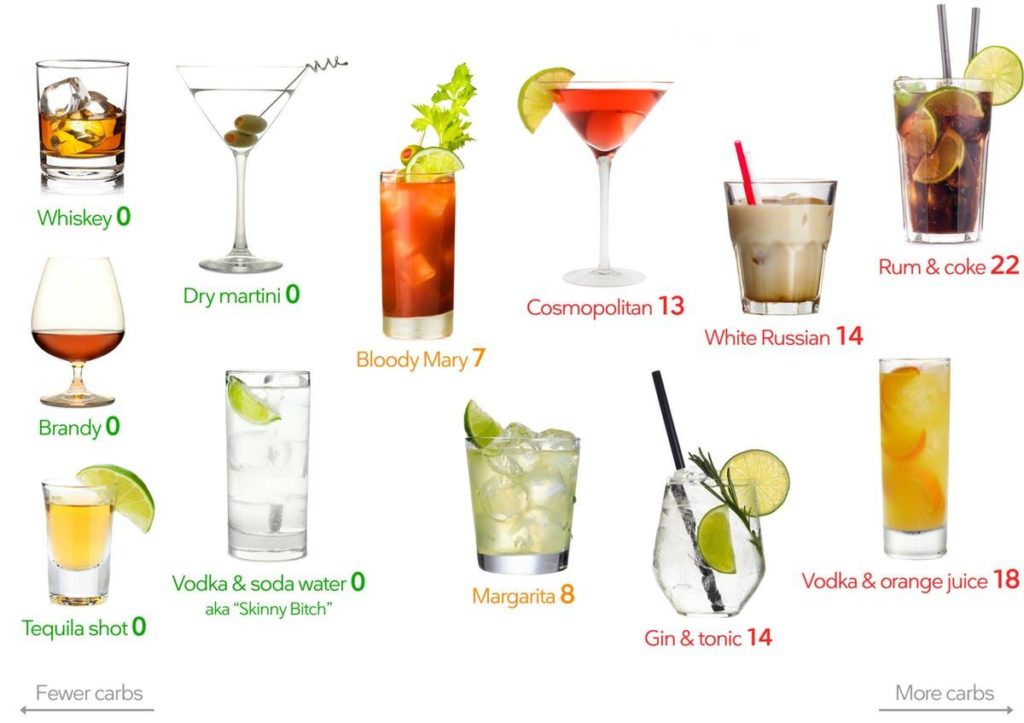
Top 5 low-carb alcoholic drinks
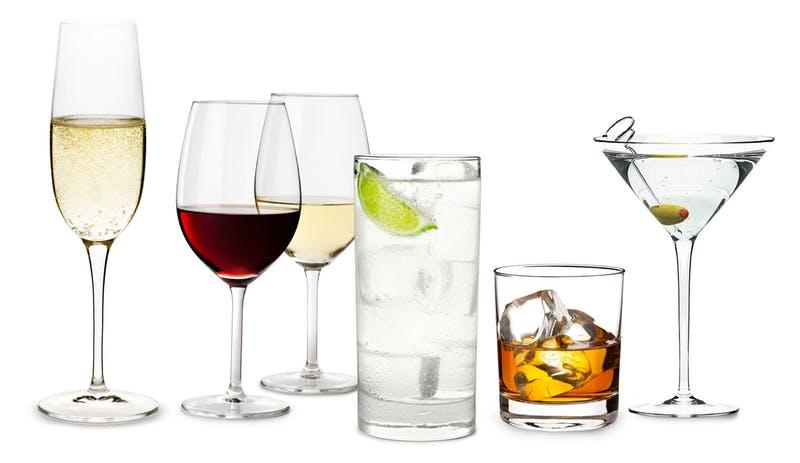
- Champagne or sparkling wine (extra dry or brut) – one glass contains about 2 grams net
- Dry wine – red or white – one glass contains about 2 grams of net carbs.
- “Skinny Bitch” – vodka, soda, lime and ice – one long drink contains 0 grams of carbs.
- Whiskey – one drink contains 0 grams of carbs.
- Dry Martini – one cocktail contains 0 grams of carbs.
Does drinking alcohol slow down weight loss on low carb?
Yes. The alcohol is burned first in the liver, slowing fat burning somewhat. Alcohol thus slows down weight loss. Furthermore, drinking alcohol can remove inhibitions, and this can result in eating things you were not planning to or needing to eat. If that happens it further slows weight loss. For effective weight loss, consume alcohol in moderation (choosing lower-carb options) or not at all.
Can you get a worse hangover on low carb?
Yes. Many people find that their tolerance is reduced on low carb, and that they are more likely to get a hangover. To minimize it don’t over-consume alcohol, and make sure to drink enough water.
What are the best alcoholic drinks that are low in carbs?
The top low-carb drinks are wine (dry white or red), champagne and pure zero-carb spirits like whiskey, gin or vodka (avoid cocktails with sugar in them).
Summary of what to eat
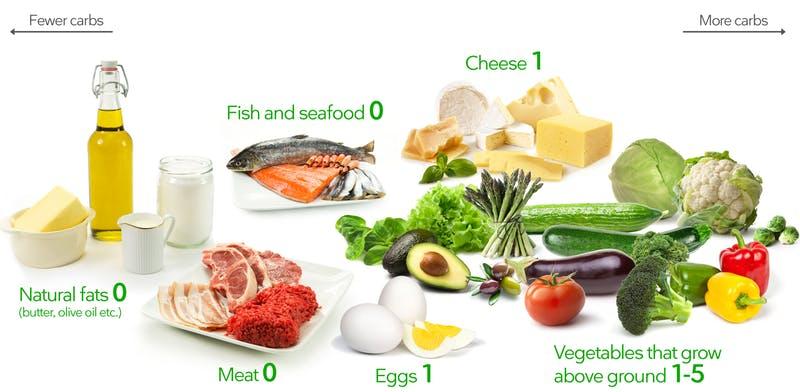
Drinks

In summary, eat real low-carb foods like meat, fish, eggs, vegetables and natural fats like butter or olive oil. As a basic beginner’s rule, stick to foods with fewer than 5% carbs (numbers above). Drink water, coffee, tea or the occasional glass of wine.
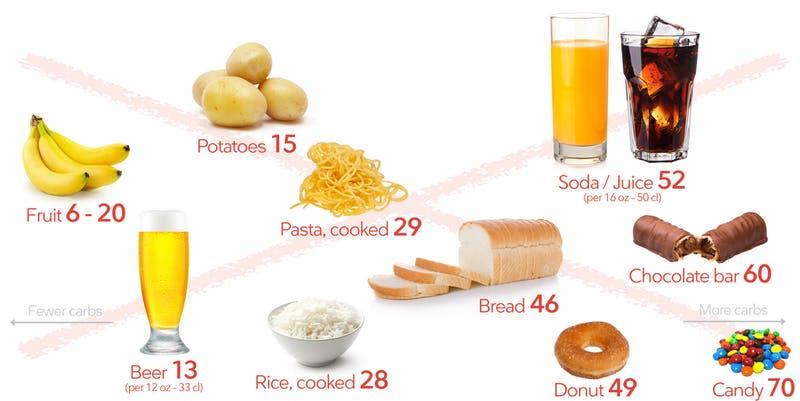
Here’s what you should not eat on a keto diet – foods full of sugar and starch. As you can see, these foods are much higher in carbs.

Douglas Miller, M.D.
Dr. Miller is a board-certified physician with training in
Internal Medicine, Emergency Medicine and
Advanced Bioidentical Hormone Replacement Therapy.

